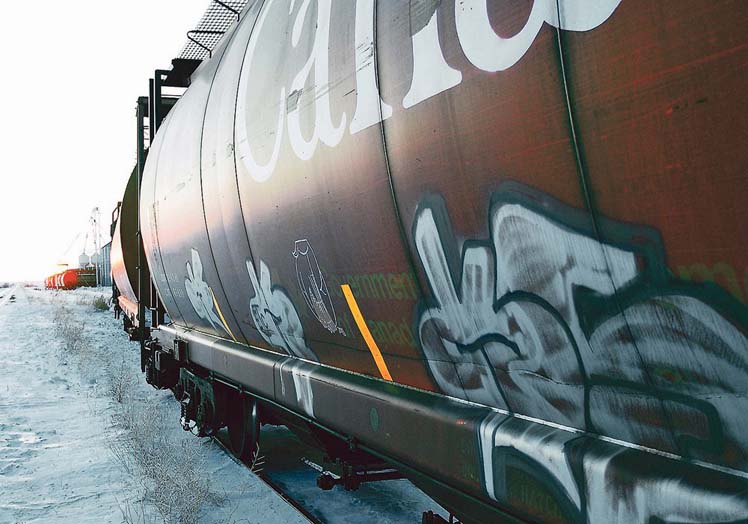

in Deadly Derailment
Kicking Horse River British Columbia - Cold temperatures, snow-covered tracks, and avalanches can cause winter shipping problems for the
rail system.
Canada's Transportation Safety Board (TSB) released some details last week stemming from the deadly derailment of a westbound CP grain train in a mountainous
area near Field, B.C.
On 4 Feb 2019 CP train 301, a 112 car, three-locomotive, grain train destined for Vancouver, derailed at Mile 130.6 of the Laggan subdivision, killing three
crew members on board.
Killed in the derailment were engineer Andrew Dockrell, conductor Dylan Paradis, and trainee Daniel Waldenburger-Bulmer.
TSB investigators who attended the crash site confirmed that 99 grain cars and two locomotives derailed in the incident.
Only 13 hoppers cars and a tail-end locomotive remained on the track, TSB said in a 5 Feb 2019 update.
The accident took place on a treacherous section of track between the Laggan subdivision's upper and lower spiral tunnels, in an area known among railroaders
as one of the most challenging sections of track in the country.
Preliminary indications suggest that the train had been stopped with the air brakes applied in emergency at Partridge, the last station before the entrance of
the upper spiral tunnel.
While the train was parked, a crew change was completed and the new crew, Dockrell, Paradis, and Waldenburger-Bulmer, boarded the train.
The train had been stopped on grade, with airbrakes applied in emergency mode for about two hours, when it began to move on its own.
TSB documents said the train then accelerated to a speed "well in excess of maximum track speed of 20 miles per hour" in an area characterized by
tight curves and steep mountain grades.
The lead locomotive and some of the loaded grain cars derailed on a curve before a bridge and crashed into a creek below.
Other cars and a mid-train locomotive piled up behind.
The 112 car train was using distributed power, where multiple locomotives are distributed throughout the length of the train to improve train control and
maintain the air pressure needed for rail car braking systems.
According to a CP report entitled "White Paper: Railroading in the Canadian Winter", distributed power trains allow for "continued air pressure
through the braking system, thereby helping reduce some of the delays associated with air brake systems in cold weather."
Distributed power also reduces the need to break apart 7,000 foot unit trains that must cross the Rocky Mountains en route to Vancouver.
The derailment occurred at about 01:00 with temperatures reported in the range of -20 C.
CP train traffic was restored to the line, CP's primary route between Calgary and Vancouver, as of early 6 Feb 2019, less than 72 hours after the
derailment.
Following the incident, CP executive Keith Creel expressed "deep sadness" at the passing of three CP members.
"This is a tragedy that will have a long-lasting impact on our family of railroaders," Creel said in a written statement.
"In the hours ahead, we remain focused on employee safety, in addition to working closely with the families of the deceased and all our employees,"
he added.
Creel said the company will not speculate on what caused the derailment because the incident is under investigation.
CP's Laggan subdivision near Field was the site of another derailment just a few weeks ago.
On 3 Jan 2019 15 cars from a mixed cargo freight train derailed near Field.
No injuries were reported in that incident.
Last week, a veteran railroader who spoke to The Western Producer on the condition that his identity not be revealed said "any number of things"
could have gone wrong with the train involved in the fatal 4 Feb 2019 derailment.
Running 7,000 foot unit trains through the mountains can be dangerous in ideal conditions, let alone when temperatures are approaching -20 C and air-brake
systems are more prone to failure, he said.
A fully loaded 112 car grain train is capable of hauling about 10,400 tonnes of wheat.
Prairie grain trains are expected to increase in length and weight as railway companies including CP seek to increase operational efficiencies and move more
cargo with fewer trains.
For example, the introduction of new CP hopper cars that are shorter and have higher hauling capacities will increase the maximum tonnage of a dedicated
7,000 foot grain train to 12,040 tonnes, CP's website states.
Plans are also in place to move to 8,500 foot grain trains comprising 147 high volume cars.
Such a train would be capable of moving 15,000 tonnes of wheat.
In its white paper on winter railroading, CP highlighted some of the challenges associated with winter shipping, suggesting that cold winter temperatures,
snow-covered tracks, and avalanches can negatively affect the rail system's overall velocity and shipping capacity.
The report goes on to state that the impact of winter weather on the rail system's overall performance is typically measured with two metrics, train speed and
train length.
Train speeds are reduced when temperatures drop below -25 C, the report states.
"These speed reductions are critical to safe operations in extreme cold."
Similarly, the CP report states that cold weather increases air leakage in a train's air-brake system, resulting in varying air pressure between the head-end
and the tail-end of a train.
Canadian railway companies typically shorten train lengths when temperatures drop below -25 C.
The practice reduces the risks faced by railroaders but requires that unit grain trains that are matched with incoming ocean vessels at Vancouver be broken
apart with some of the cars shipped in a separate movement.
Harsh winter conditions can also increase the likelihood of broken rails and switches, signal outages, locomotive failures, and rail car defects.
TSB officials investigating the 4 Feb 2019 incident said last week they were still hoping to gain event recorder data from the lead locomotive.
The TSB's investigation will determine the causes and contributing factors to the derailment.
Brian Cross.
provisions in Section 29 of the Canadian
Copyright Modernization Act.

